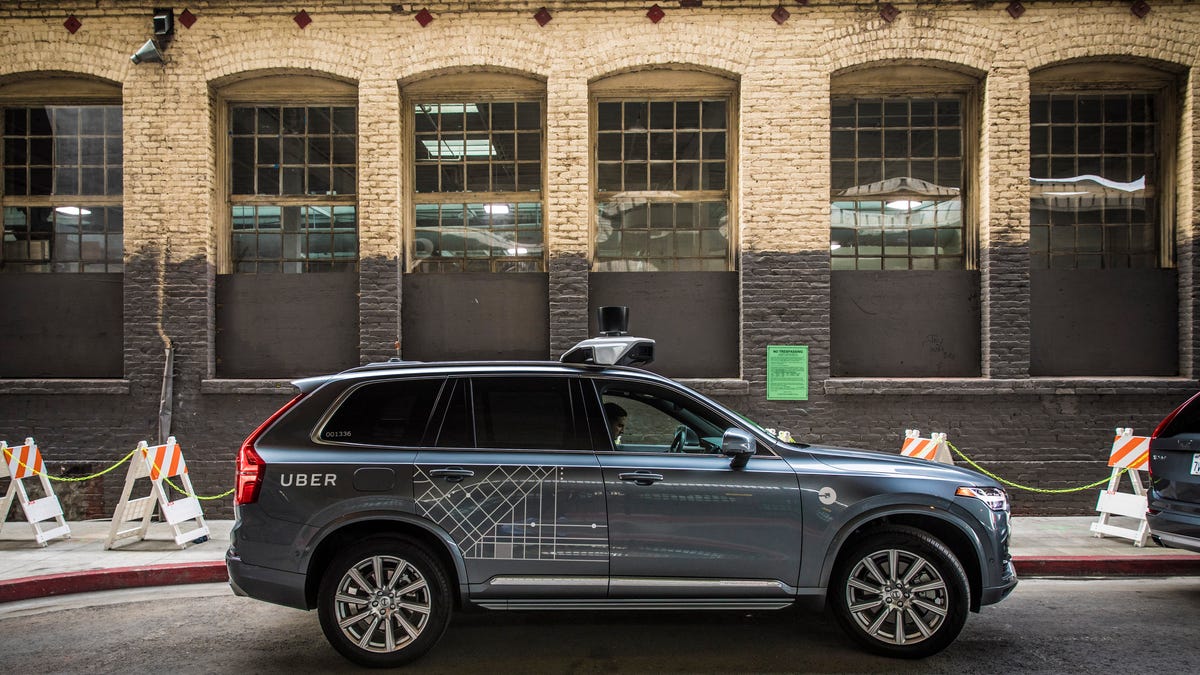Here's how your Uber is learning to drive
Behind the wheel of the ride-hailing company's self-driving cars are "safety drivers." They're responsible for taking control if anything happens.

Here's one of Uber's self-driving Volvos.
Before Rick McKahan could even get behind the wheel of one of Uber's self-driving cars as a "safety driver," he had to spend days driving around a small simulated city in Pennsylvania, handling corners and dodging obstacles.
Now he's tasked with training other safety drivers at Uber's test track in Pittsburgh.
At the ride-hailing company's autonomous vehicle training facility on the banks of the city's lush, green Monongahela River, aka "The Mon," Uber's self-driving cars learn to navigate the roads. And prospective safety drivers spend three weeks learning to operate the robo-cars -- Ford Fusions and Volvo XC90s -- so they can take over when needed.
"When we simulate real world experiences, we make that the worse-case scenario," said McKahan, a 28-year-old who was an oil and gas professional before he joined Uber last year to become a vehicle operator trainer. "When they get off the test track and get onto the public road, that actually seems easier than the first week of training."
As self-driving cars circle around grassy knolls and past parked cars at the closed-course facility, passenger doors suddenly fly open to test whether vehicles will safely steer out of the way. Jaywalking zombielike mannequins scoot out in front of moving automobiles to teach the cars to stop for pedestrians before it's too late.
Self-driving cars use a series of sensors, lasers and cameras to "see" their surroundings and detect traffic, pedestrians, bicyclists and other obstacles. Uber is one of dozens of companies working on bringing the futuristic tech to the roads. Automakers from Toyota to Ford to Volvo all have projects underway, as do Silicon Valley giants including Google, Apple and Tesla.
Uber started working on self-driving cars in 2015 and is the first company to roll out autonomous vehicles to the public. It brought a small fleet of self-driving cars to passengers in Pittsburgh in September 2016. The company has since driven more than 1 million autonomous miles and is testing about 200 cars in Pennsylvania, Arizona and California.
Uber's self-driving cars lined up behind a warehouse in downtown San Francisco last December.
Uber's autonomous vehicle project isn't free from controversy, though. The company is currently in a legal battle with Waymo, the self-driving car unit of Google parent company Alphabet. Waymo accused Uber of stealing its autonomous vehicle technology; Uber calls Waymo's claims "baseless." The trial is slated to begin in December.
The ride-hailing company is also reeling from a botched launch of its self-driving cars to passengers in San Francisco last December. After Uber failed to secure permission from the state's Department of Motor Vehicles to have its cars on the road, it was forced to halt the passenger program. Uber also had to deal with a handful of safety issues during that time, including one vehicle caught running a red light.
Since then, its self-driving cars have been involved in minor accidents in Pittsburgh and Tempe, Arizona. Even though injuries weren't reported and police determined Uber wasn't at fault for the crashes, it's up to the company to show the public its self-driving cars are safe.
Backseat driver
Companies working on self-driving car tech say these vehicles will one day be safer than driver-controlled autos and that they can also help ease traffic congestion and eliminate drunk driving. But until that future arrives, a safety driver needs to be in each car.
Anyone with a clean driving record can sign up to be one of Uber's hundreds of vehicle operators, but applicants must first go through a series of driving tests in a regular car. If they pass those and get through the interview process, they'll next enter Uber's three-week training period.
Week one of training includes classroom instruction, exams and supervised driving at the test track. In weeks two and three, trainees go out onto public roads but only on preselected routes with an experienced operator, aka a backseat driver. Uber declined to say how much its safety drivers earn.
"We have a very strict process for bringing drivers onto our program," McKahan said. "Part of that process is with a professional driving company where they learn how to operate a vehicle in situations that might be less than ideal."
Uber's test track in Pittsburgh where it trains "safety drivers" how to control self-driving cars.
This training program constantly shifts to deal with the technology as it evolves and conditions change. For example, snow on the ground could change how a vehicle acts and reacts, so drivers need to be ready for that. There are also the normal ins and outs of driving in a city.
"We're in a really jam-packed city here in Pittsburgh," McKahan said. "Every day we're dealing with pedestrians, bicyclists, different traffic lights, construction zones -- just anything that is a challenge for a vehicle or a driver."
When safety drivers are at the wheel of a self-driving car (without actually holding onto the steering wheel), they're not sitting back and relaxing, McKahan said. They have to be actively monitoring what the vehicle is doing and documenting the behavior of the car. It's still a learning process for both the car and the drivers.
I ask McKahan if he'd be OK being a passenger in a self-driving car without a safety driver.
"Maybe on the track, at this point," he said. "In a controlled environment."
Uber puts self-driving cars on the road: In 2016, the ride-hailing app launched its own fleet of self-driving cars for passengers in Pittsburgh and San Francisco.
Roadshow: Everything about the intersection of cars and technology.

